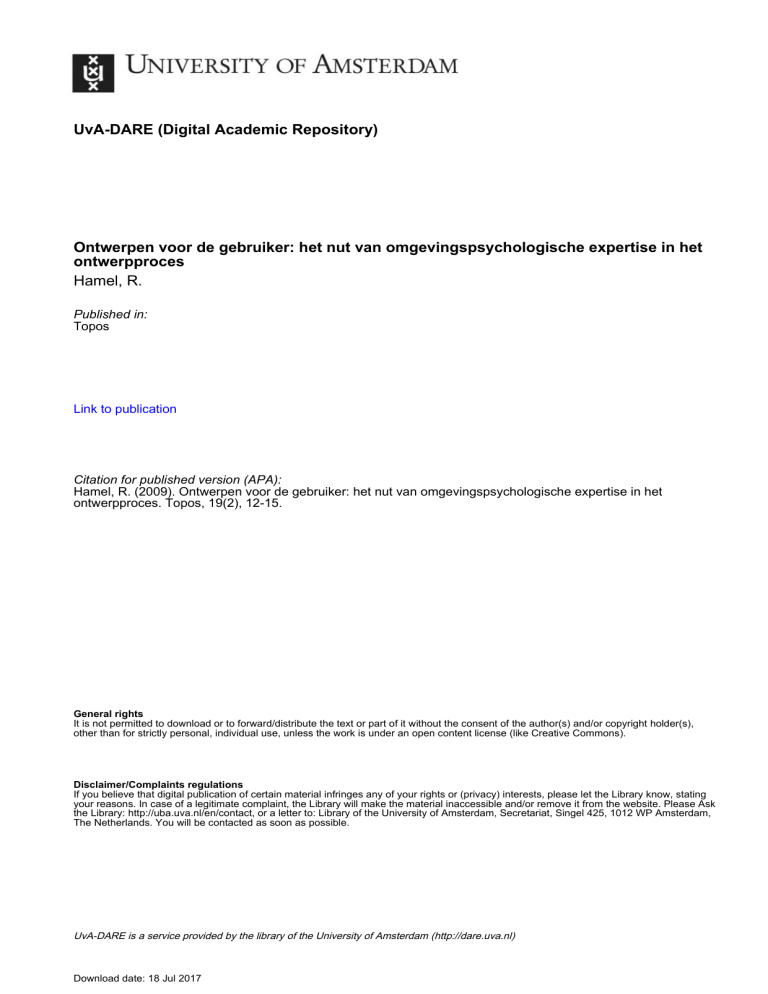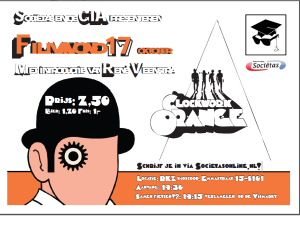
UvA-DARE (Digital Academic Repository)
Ontwerpen voor de gebruiker: het nut van omgevingspsychologische expertise in het
ontwerpproces
Hamel, R.
Published in:
Topos
Link to publication
Citation for published version (APA):
Hamel, R. (2009). Ontwerpen voor de gebruiker: het nut van omgevingspsychologische expertise in het
ontwerpproces. Topos, 19(2), 12-15.
General rights
It is not permitted to download or to forward/distribute the text or part of it without the consent of the author(s) and/or copyright holder(s),
other than for strictly personal, individual use, unless the work is under an open content license (like Creative Commons).
Disclaimer/Complaints regulations
If you believe that digital publication of certain material infringes any of your rights or (privacy) interests, please let the Library know, stating
your reasons. In case of a legitimate complaint, the Library will make the material inaccessible and/or remove it from the website. Please Ask
the Library: http://uba.uva.nl/en/contact, or a letter to: Library of the University of Amsterdam, Secretariat, Singel 425, 1012 WP Amsterdam,
The Netherlands. You will be contacted as soon as possible.
UvA-DARE is a service provided by the library of the University of Amsterdam (http://dare.uva.nl)
Download date: 18 Jul 2017
Ontwerpen voor de gebruiker
Het nut van omgevingspsychologische expertise in het ontwerpproces
Ronald Hamel is verbonden
aan de Afdeling
Psychologie van de
Faculteit der Maatschappijen Gedrags-wetenschappen
van de Universiteit van
Amsterdam. Hij geeft
onderwijs in de cognitieve
psychologie en de
omgevingspsychologie.
Zijn onderzoek is ook op
die gebieden: denken en
kennisontwikkeling tijdens
het ontwerpproces en de
beleving van de omgeving.
! "!!!
#
$
#
"
! #
!
!%
&
!
!
&
!
'
(
!
(
)
(
*+,
&-./
-/
-/
'
Ronald Hamel
Programmagroep Psychonomie
Universiteit van Amsterdam
[email protected]
12
TOPOS / 02 / 2009
Dit pad is in de binnentuin van een verzorgingshuis annex verpleeghuis. Het ziet er leuk uit,
maar is het begaanbaar voor iemand die in een rolstoel zit of met een rollator loopt?
.
!
(
!
! !
#
!
'.
!
0#0
1
)
&
!
2
3
!
$&.
! .
0
(
Is het Museumplein in Amsterdam om naar te kijken of om te gebruiken?
4
"
! 0
#
5.
! !3
5
'
6
)
7
'
!
Utilitas
"!
!
9
:
-;!
,<<=/-;#;/
! >
!
'
! >
-
!!
$,<<?/@
!
@!
!
! TOPOS / 02 / 2009
13
!
'
@!
#
3
- ,<<A/#
(
!
"
11
! B
CD
0
-:E
9F:,<<A/3
-
14
TOPOS / 02 / 2009
De ArenA Boulevard in Amsterdam. Veel verschillende gebruikers: winkelpubliek, bezoekers
Voor al die groepen is de beleving van de omgeving anders.
/
.
7
! '
.G
'
.
'
B
#
&
&
'
-!! /(
)
!
)
-
! /
!
-
#&./
!
!
! '
! :
! "
!
. !#
4>
.
@
.
#
!
!
:
De leesbaarheid van de omgeving hangt af van:
1. Differentiatie (beïnvloedt de herkenbaarheid)
2. Visuele toegankelijkheid
3. Complexiteit (beïnvloedt de voorspelbaarheid)
In een leesbare omgeving kunnen mensen zich goed oriënteren en ervaren zij meer sociale
veiligheid.
! ! -1/
#
3
!
0
'
3
&-*/
-,/
-+/
!
Literatuur
:B)E769HF:)
,<<A#-=/;
I
&7F9
$,<<?930
0
B"&"@
;!#,<<=:!
:& '
*??JK
7BL)&
)GB
F E
9,<<A:! !D"
!! DB6@! ;I
Summary
This article describes the practice and
knowledge of designing. It especially
focuses on the ability of designers to
design where their knowledge is
restricted or even lacking. The
designers’ knowledge about the
(potential) users of the environment is
psychologists could provide additional
knowledge from theory, research
literature, evaluation of environments
in use, and experiences from other
projects. Their contribution could be
especially useful in the analysis at the
beginning of the design process, in the
evaluation of concepts and at the end
with the explanation of the
perceptional, experiential, and
behavioral qualities of the design.
TOPOS / 02 / 2009
15












